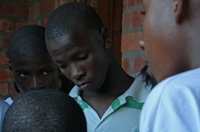Kristin Palitza
CAPE TOWN, May 5 2010 (IPS) – I sometimes drink alcohol because it makes things funny, 15-year-old Senelo* giggles shyly. I go to unlicensed taverns. They sell alcohol without asking questions.

Many South African teenagers are exposed to behaviour detrimental to their health. Credit: Kristin Palitza/IPS
The petite, pretty teenager from Mfuleni township 35 kilometres outside of Cape Town is far from being an exception. Thirty-five percent of South African adolescents say they drink alcohol, and 29 percent binge drink.
This is according to a 2008 Youth Risk Behaviour Survey by the national Medical Research Council (MRC), released in April. MRC researchers interviewed more than 10,000 pupils of Grades 8 to 11 in over 200 public secondary schools countrywide.
I mainly drink beer and mixed drinks, but when I m drunk I have to vomit, Senelo explained while nervously running her hand through her hair, clearly aware that her behaviour is not age-appropriate. When I go home, I make sure my mother doesn t see me so she doesn t worry.
Researchers believe the level of teenage alcohol consumption in South Africa is alarming. Alcohol is too readily available, because it is part of almost all social interactions, noted Aadielah Maker, senior executive of social mobilisation at The Soul City Institute for Health and Development Communication.
Apart from alcohol consummation, intake of other drugs is also high. Almost a third of learners reported having smoked tobacco. In addition, 13 percent admitted they had smoked marihuana, 12 percent had tried inhalants and seven percent had done cocaine, methamphetamine or Mandrax (methaqualone).
Related IPS Articles
In my community, there are lots of guys that smoke dagga [marihuana], tik [methampehtamine] or sniff glue, confirmed Jabulani*, a lanky 17-year-old who says he spends most of his free time on the soccer field. I try to stay away from them. Most of them identify with the gangs, and many are involved in crime.
About 15 percent of youth reported carrying weapons, and 19 percent said they belong to gangs, the MRC found. This is extremely worrying. We believe this is linked to teenagers need for identity and indicates lack of family support, said MRC senior clinical trial manager of the Health Promotion Research and Development Unit Dr. Shegs James.
In the past six months, a quarter of learners reported having experienced feelings of sadness or hopelessness. Twenty-one percent had considered suicide, while another 21 percent had attempted to take their lives. Those numbers are substantial. It is disheartening to see that youths emotional state is so fragile, noted James.
Fifteen-year-old Thabo* says many of his peers feel this way: Lots of my friends are sad and depressed. They are hopeless about the future. One of my friends is HIV-positive. He just sits at home and cries and was trying to kill himself.
Grace Mathlape, chief executive officer of HIV prevention organisation LoveLife, says the study paints a picture of young people who generally lack support: There seems to be a great sense of helplessness that leads to increased risk taking. What makes matters worse is that all these behaviours perpetuate each other.
Alcohol, often an entry drug, increases the likelihood of other risky behaviours, such as drug use, exposure to violence and unsafe sexual behaviour.
Almost 40 percent of 13- to 19-year-olds said they have had sex, with 13 percent reporting they first had sexual intercourse while under the age of 14, according to the study. Among the learners that had sex, 41 percent had more than one past sexual partner, 16 percent had sex after consuming alcohol and 14 percent had sex after taking drugs.
Less than a third practiced consistent condom use, while 10 percent said they had been forced to have sex. Chances are high that they are exposed to HIV and other sexually transmitted infections, cautioned James.
Condom use was low despite the fact that 65 percent said they had received HIV education.
Knowledge doesn t seem to be the problem, but access to services is, said Maker. Young people are often discriminated by health workers when they try to access contraceptives or condoms at their local clinic.
Senelo knows this from personal experience. I once went to the clinic because I had vaginal discharge. The nurse shouted at me, saying I am too young to have a boyfriend. She was not nice, she remembers. But I never had sex. Now, I would never be comfortable to go back there to ask for contraception.
Lack of access to health services also translates into a high number of unwanted pregnancies. Almost 20 percentof teenagers said they had been pregnant or made someone pregnant, which James described as a pretty high percentage. Ideally, you would want the figure to be below five percent.
When dividing the study results into three levels of risk taking 17.5 percent and 16.6 percent constituted the intermediate and higher risk clusters respectively.
This means that about a third of South African youth is somehow in trouble. That s something to be very wary of, warned James. Although it is difficult to pinpoint reasons for high risk-taking behaviour, she believes that a mixture of social and economic factors, lack of parental control and value systems play a role.
Unless we do something, the crisis will reach pathological proportions, Mathlape warned. The stats are extremely frightening.
She called for large-scale youth programmes that are tailored to different ages and have a broad focus on reducing all health risks. Currently, most youth health initiatives in South Africa focus on sexual behaviour.
MRC researchers hope the study results will mobilise different government departments, such as education and health, to make budgets available to implement such programmes nationwide.
*Names of minors have been changed.